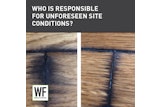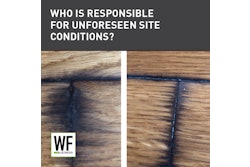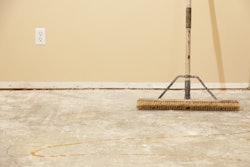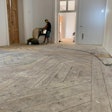John had invested long hours and a lot of money installing, sanding and finishing 2,500 square feet of bubinga in a new house. Atticus Building Co. had built the house and subcontracted John to install the floor. After John finished, some electricians on the site told him that Atticus Building was almost bankrupt and probably wouldn't pay John or the other subcontractors for their work. John remembered that his friend Larry once had a claim of lien against property when a homeowner never paid him for the floor he installed, so John thought a lien would be able to secure his payment in this situation, as well.
John researched his state's lien laws online and hired a lawyer to help him through the lien process. After a year, he and the other subcontractors for the job were able to force the sale of the house in order to acquire their lien payment. Had he not done so, John wouldn't have received any money for all his work.
A contractor, subcontractor or materials supplier who performed work to improve real estate but wasn't paid can use a mechanics lien as a claim against that property. Ultimately, the person who makes a claim of lien can force the sale of that property in order to receive payment. If several subcontractors claim liens on the same house, as in John's case, the sale will be divided among them proportionately.
Although lien laws may be similar between states, no two states have identical procedures. Before starting a project, you should talk with your lawyer to familiarize yourself with your state's requirements for filing liens. In this article, I'll use Michigan's Construction Lien Act as a general example of lien procedures during construction and foreclosure litigation.
The Owner's Responsibilities
When starting a construction project in Michigan, the homeowner must prepare and record a Notice of Commencement, which identifies the homeowner and the contractor, as well as the location of the construction project.
The Notice of Commencement must be recorded with the register of deeds office in the county where the property is located and must also be posted at the job site. The homeowner must name an "owner's designee" on the Notice of Commencement. The designee is the person who receives notices from contractors and suppliers under the Lien Act.
Contractor's Responsibilities
The Lien Act defines a contractor as a party having a contract with the owner. Contractors often subcontract with other parties, such as flooring contractors, to perform all or some of the work they promised to the owner. When a homeowner hires a general contractor, she isn't bound by contract to the subcontractors and suppliers and may not even know who the general contractor hired. To identify themselves to the owner, the Lien Act permits subcontractors and suppliers to provide the owner and the general contractor with a document known as a Notice of Furnishing, which must be served to the owner's designee and the general contractor within 20 days after the first work or supplies are furnished. In that case, the lien rights of the subcontractor or supplier are protected from the first day of work. If the Notice of Furnishing is served after the 20 t h day, the lien rights for the time period before that may not be protected.
In order to ensure protection, flooring subcontractors and suppliers are encouraged to obtain a copy of the owner's Notice of Commencement to prove that their Notice of Furnishing was served within the proper time period. The flooring contractor should get this immediately after winning a contract or even during the bidding process.
The Claim of Lien
In order to preserve lien rights, a Claim of Lien must be recorded with the register of deeds office in the county where the project is located within 90 days after the last work was done. In some states there are no exceptions to this, even if the subcontractor didn't receive a Notice of Commencement.
The project owner may try to challenge the validity of the lien. A common challenge is based on a dispute regarding whether the subcontractor actually provided services on the claimed "last day" of the project. Accordingly, I recommend flooring contractors keep records regarding the days they worked on the project in the form of time cards completed by their laborers, field reports completed by the site manager, and similar reports.
Recording the Claim of Lien with the register of deeds office is a simple process. The claim must be prepared in "recordable form" (which means using the paper size and margins required by the register of deeds office). There's usually a modest fee for the recording. Be sure to have extra copies of your claim so the clerk can time-stamp one to show the date you presented it for recording. This shows that the claim was recorded on time. Michigan case law says that if the claim of lien was presented for recording within the 90-day period, then it will be valid, even if the register of deeds does not actually record it until some time after the 90 th day. Subcontractors should also obtain a receipt to show that they paid for their Claim of Lien.
The claim must then be served to the owner's designee and the general contractor within the required time after it was recorded, as specified by state law. Subcontractors and suppliers need to know these time limits, as well as any required methods for the service of the Claim of Lien.
The Lien Foreclosure Suit
While properly recording the claim protects the subcontractor's rights, it may not directly or immediately produce payment. If it doesn't, subcontractors must bring a lawsuit to foreclose the lien. There may be a time limit regarding when foreclosure suits can be filed. In Michigan, the suit must be filed within one year after the Claim of Lien was recorded. The lienholder who starts a foreclosure action may have to include all persons/entities who have an interest in the property in the suit. This will typically include the owner, other lienholders and a bank or mortgage company, and these parties may also make claims to foreclose their respective liens. Before filing the suit, the lienholder should conduct a title search to properly identify these other parties.
Residential Projects
Certain states may have special rules regarding residential construction projects. In Michigan, contractors who contract directly with the homeowner must have a written contract that contains a statement regarding licensing and the contractor's license number. Any additions or amendments to the contract must be also be in writing.
State lien laws provide a set of relatively simple procedures that allow contractors, subcontractors and suppliers to protect their lien rights and allow owners and general contractors to know the parties working on a construction project. By following these procedures, the interests of all parties are protected. I recommend that flooring contractors and suppliers become familiar with these procedures so that they may properly protect themselves and their businesses.
Note: The information contained in this article does not constitute legal advice. This article is not designed to describe all or any of the provisions of any state's laws and is for general informational purposes only.
































